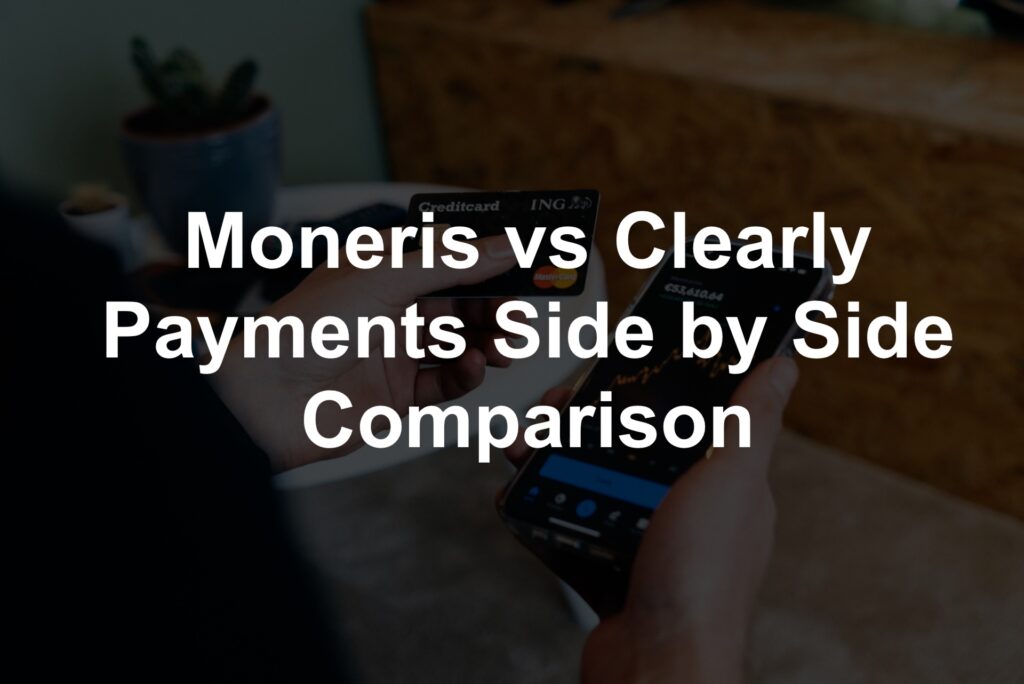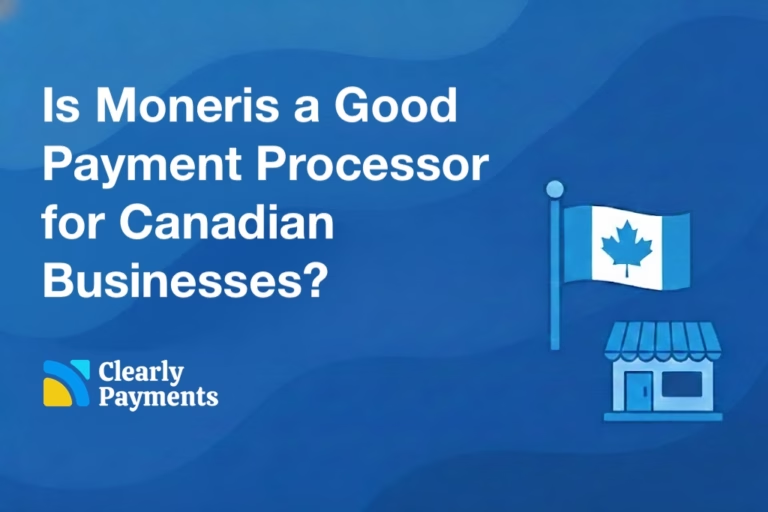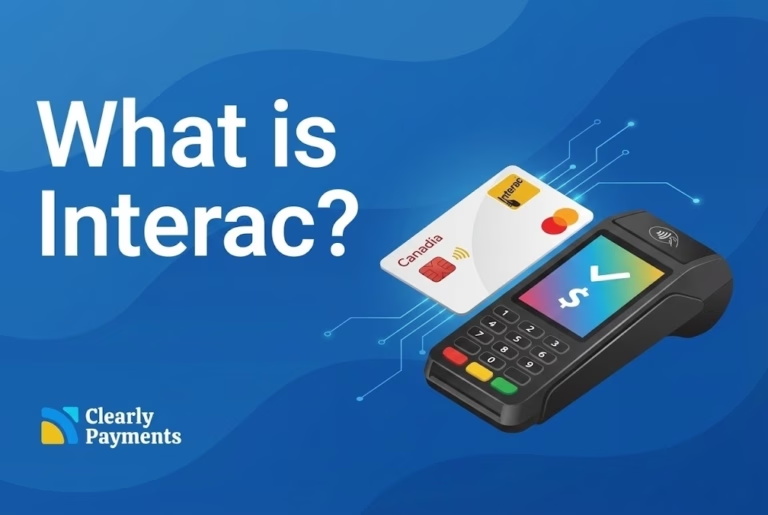Choosing the right payment processor can significantly impact a business’s operational efficiency, customer satisfaction, and bottom line.
Two players in the Canadian payment processing industry — Moneris and Clearly Payments — represent contrasting approaches in terms of size, customer experience, and flexibility.
This article provides a side-by-side comparison of these two companies to help businesses make an informed decision.
Overview of Moneris and Clearly Payments
| Feature | Moneris | Clearly Payments |
|---|---|---|
| Headquarters | Toronto, ON | Vancouver, BC |
| Ownership | Joint venture of RBC and BMO | Independent, privately held |
| Market Focus | Enterprises and SMBs | SMBs, SaaS, and Enterprises |
| Years in Operation | Founded in 2000 | Founded in 2018 |
| Customer Support | Traditional call center support | High-touch personalized support |
| Fee Structure | Tiered and sometimes opaque | Interchange-plus, transparent |
Company Backgrounds
Moneris: Moneris Solutions Corporation, founded in 2000 as a joint venture between two of Canada’s largest banks—Royal Bank of Canada (RBC) and Bank of Montreal (BMO)—is one of the largest payment processors in the country. With a vast infrastructure, Moneris services hundreds of thousands of businesses across Canada, offering everything from point-of-sale (POS) terminals to e-commerce integration, with strong banking relationships and deep compliance capabilities.
Clearly Payments: Clearly Payments, an established player in Vancouver, British Columbia, is an independent payment processor that positions itself as a low-cost and highly transparent alternative. Founded on principles of fairness and openness, the company seeks to modernize the payment experience with open pricing, simple onboarding, and superior service, especially for small and medium-sized businesses (SMBs), software platforms, and enterprises underserved by traditional providers.
Key Differences of Moneris and Clearly Payments
1. Pricing and Transparency
Moneris is understood to offer a tiered pricing model, which can make it difficult for merchants to understand the exact rates they are paying for each transaction. While enterprise clients may negotiate better rates, smaller merchants often face higher and more opaque fees. Monthly fees, statement charges, and contract penalties are common.
Clearly Payments uses an interchange-plus pricing model, which breaks down fees into the wholesale interchange rate (set by card networks like Visa and Mastercard) plus a fixed markup. This model is widely regarded as the most transparent in the industry. Clearly Payments also markets itself as having no setup fees, cancellation fees, or long-term contracts.
Verdict: Clearly Payments offers a more transparent and merchant-friendly pricing model.
2. Customer Support and Service
Moneris provides conventional customer service through its call centers and online portals. Some support is run outside of Canada. With a large customer base, experiences may vary, and support may feel transactional rather than personal. However, the scale allows Moneris to provide 24/7 technical support and access to multilingual agents.
Clearly Payments focuses on personalized customer support with all staff based in Canada. Customers often receive a dedicated account manager, direct email support, and faster response times. The company positions itself as a “human-first” service provider, particularly appealing to businesses that want more than just a vendor.
Verdict: Clearly Payments stands out for its high-touch and customized support approach.
3. Product Offering and Technology
| Category | Moneris | Clearly Payments |
|---|---|---|
| POS Terminals | Proprietary hardware, rental models such as Ingenico and Verifone | Clover, Poynt, and other 3rd-party hardware such as Ingenico and Verifone |
| E-commerce Integration | Extensive integrations with Magento, and WooCommerce | Strong e-commerce and API support, developer-friendly also supporting Magento and WooCommerce |
| Invoicing & Recurring | Provided through partner tools | Built-in recurring billing and invoicing features |
| API & SDK Access | Customization, high enterprise focus | Open APIs for SaaS and platform developers |
Moneris benefits from years of enterprise integration and solid banking infrastructure. Its hardware is proprietary, and it often requires businesses to rent terminals. While it has expanded into digital products and e-commerce, its flexibility is limited compared to modern developer-focused processors.
Clearly Payments is API-first, built with flexibility for modern businesses in mind. It supports all common integrations for web, mobile, and in-person transactions. Its platform is popular with SaaS companies and developers looking to embed payments directly into their products.
Verdict: Both companies have a flexible technology stack.
4. Contracts and Commitments
Moneris usually requires multi-year contracts with early termination fees. Leasing hardware is also common, which can lead to unexpected long-term costs.
Clearly Payments offers month-to-month agreements with no cancellation or early termination fees. Hardware can be purchased outright or provided at cost, which helps businesses maintain control.
Verdict: Clearly Payments provides more contract flexibility.
5. Target Market and Use Cases
Moneris caters to a wide range of businesses, but its sweet spot is traditional brick-and-mortar merchants and large enterprises looking for reliability and banking integration. Its strength is in scale and operational stability.
Clearly Payments targets small to medium-sized businesses, software platforms (ISVs), and enterprises such as healthcare, dental, retail, software, and more. It appeals to businesses looking for modern tools and flexibility over legacy relationships.
Verdict: Depends on the business type. Moneris is ideal for very large institutions; Clearly Payments is better suited for growing and agile businesses up to $100 million in revenue.
5. Security and Compliance
Verdict: Both are secure, but Moneris may have an edge in enterprise-grade compliance tooling.
Overall summary of the Pros and Cons
| Feature | Moneris | Clearly Payments |
|---|---|---|
| Pros | Trusted, established, strong banking ties, scalable | Transparent pricing, great support, modern tools, flexible |
| Cons | Long contracts, opaque pricing, less flexibility | Less known, limited banking integration |
| Best For | Enterprises, traditional retail, banking customers | Startups, SMBs, SaaS platforms, enterprises up to $100 million in revenue |




